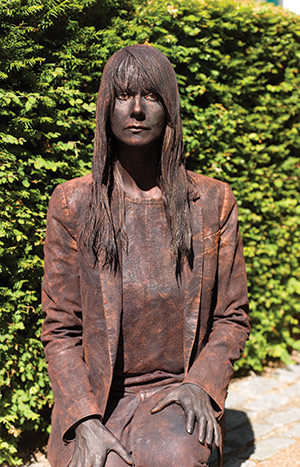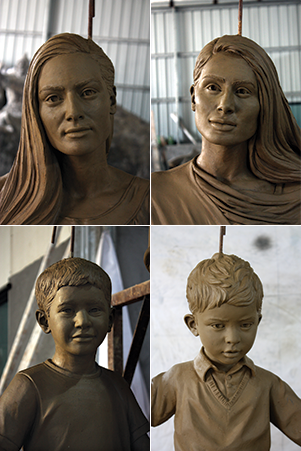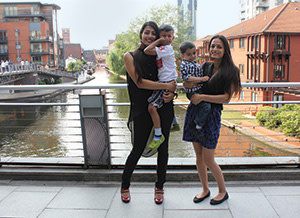Statue of a family: by Gillian Wearing
Simply sign up to the Life & Arts myFT Digest -- delivered directly to your inbox.
Way back in the dying days of the last millennium, there was still a giant-sized question mark over the future of British contemporary art. There was no Tate Modern, no Frieze Art Fair and a deep-lying suspicion that a new generation of the country’s young artists – loud, irreverent and media-savvy – was more interested in sensation-seeking than proper and respectful innovation.
That feeling was cemented in the immediate aftermath of the Turner Prize ceremony of 1997. The evening was ambushed by the mangled vowels and fruity insults of a drunken Tracey Emin, who babbled her way through a live television discussion (“I want to phone my mum!”) after the dinner, prompting a barrage of filth-and-the-fury headlines that recalled the explosive rise of the Sex Pistols into stellar notoriety. Was this what British art had been reduced to? Punk incoherence and bourgeois-baiting?
Seventeen years later, only seasoned art observers remember the winner of that year’s Turner Prize (Emin was not even shortlisted). It was Gillian Wearing, whose cool, understated work reflected a very different side to Young British Art, as it had by now been labelled. Her hour-long video, “Sixty Minute Silence”, a group portrait of three rows of police officers making as little movement as possible for the duration of the film, played far more subtle games than the shocking work of her more famous contemporaries.
The delicately drawn ironies in the piece – the controllers of law and order asked here to control themselves – had a hypnotic effect. The officers’ uniformity, central to their authority, was subverted by the infinitesimal movements which betrayed their humanity. It was hard to look away. In staging her piece, Wearing was tapping into a traditional artistic theme: the nuances of identity conferred by the trappings of office. But this felt like a fresh and masterly treatment of the subject.

Wearing has, since then, produced a body of work that has further explored those compelling themes. Long before reality television, she became fascinated by the torrent of complication and poignancy that lay behind the most apparently ordinary lives. “I’m interested in people, and I’m interested in the everyday,” she tells me straightforwardly in a neat room of her east London studio. “That is what fascinates me.”
But the subject of her work is anything but straightforward. Take her new project, “A Real Birmingham Family”, for the Ikon Gallery, in which she has asked families to nominate themselves as potential models for a life-size bronze statue to be set near the city’s new library. The search asked a pointed question: what constituted a family in the 21st century? Wearing admits she wanted to shake up the received wisdom over the subject, not least by using the word “real” rather than “typical” in the title. The project attracted 370 responses.
“It was important that anyone could apply – single people, groups of friends,” says Wearing, who was herself born and raised in Birmingham. “We did some vox pops and asked people what they thought the ‘family’ was, and they said the usual things – 2.4 children and a mum and dad, and so on. And then we asked them about their own families, and it was very different: ‘Oh, it’s just me and my mum.’ It wasn’t the kind of family that they had in their heads. But a lot of the ideas we have in our heads are, of course, mediated.”
The family chosen by the jury, of which Wearing was a member, conveniently makes her point: the Joneses are two (highly photogenic) sisters, Roma and Emma, both single parents, and their two sons Kyan and Shaye. The family said that being chosen “highlights that family is an indestructible bond between people that is universal, and it doesn’t matter how it is made up or what it looks like”.
I ask Wearing what the criteria were for picking the Joneses. There were none, she says. “Everyone chose for their own reasons. There was no great discussion about all the families. We went round the table and everyone had the same idea. Some things you can’t explain.” It would have been quite a surprise if they had chosen a mum and dad and 2.4 children after all, I say. “Right,” she observes, and then leaves a pause, sniffing out an accusation of political correctness which is not entirely intended. It is a rare break in our conversation. Wearing speaks fluently and quickly, as if in a hurry to keep up with her ideas.

Working on sculpture-based projects is a relatively new departure for Wearing but typical of her tendency to deconstruct, with a light and rather charming touch, the preconceptions of her art form. Most statues are for heroes, I say. “Yes, and they feel very anonymous, standing high up, it is very hard to relate to them. I am interested in people who really exist, right now. It wasn’t a massive deconstruction. But I wanted them to be nothing to do with war or royalty or anything like that.” Many traditional statues, she adds, were of political figures who were anything but well-liked. “And a lot of them are quite badly sculpted as well.”
It is not that she is not interested in heroism. In 2011’s “Terri”, she celebrated, in the form of a painted bronze and marble statue, Terri Tobin, a media officer for the NYPD who was working at the Twin Towers on 9/11. The pose assumed by Tobin is humble, unflattering, anti-heroic. Yet it belies her actions on that day, helping to rescue victims from the rubble even though she was badly injured. “There are so many people who have done great acts, and it is highly unlikely they will ever be recognised by monuments,” Wearing says.
This is her corrective: putting ordinary lives into the spotlight when they achieve extraordinary things. “People who show humanity should be celebrated,” she says simply. “I am always looking for things that are not normally expressed.”
It is that impulse which was at the core of Wearing’s most celebrated work. In the early 1990s, not so long out of Goldsmith’s College, she made a series of explosively effective photographic portraits which brought her to art world prominence. She asked passers-by in London’s Regent’s Park to write something down on a piece of paper and hold it in front of them. The title of the series – “Signs that say what you want them to say, and not Signs that say what someone else wants you to say” – hinted at her encouragement of her subjects to rebel against the strictures of their super egos. They obliged in a remarkable variety of ways.
The series is today remembered by its most striking image: that of a youngish, blond businessman, in formal dark suit and tie, wearing a chain around his neck which may be carrying his security pass or a conference delegate’s ID. He looks into the camera with an expression that is difficult to read, a little rueful perhaps, but bearing little sign of psychic disturbance, until we see the sign he has written and is holding before him: “I’m Desperate.”
The discrepancy between image and text is full of pathos and sadness. I ask Wearing if she had straight away appreciated the strength of the work. “I remember we didn’t really have a conversation afterwards,” she says of meeting the man. “He just left quite abruptly. I didn’t really realise until I got the images back that it was going to be something quite significant. And then I just thought, oh my goodness, the way he stood and the way he engaged with the camera … ”
Many images in the “Signs” series proved to possess an equally unsettling power. A chirpy-looking middle-aged woman in glasses pronounces: “I am depressed at the moment.” A fashionably dressed young man with a neck-scarf around his mouth says “All I ever wanted was love”, the text accompanied by a radiant, childish sun in the top corner and a palm tree in the bottom. An African-Caribbean man wearing a Boston Panthers cap finds his inner social commentator: “The political situation in England is stable.”
Was Wearing surprised by the candour of her subjects? “Yeah, I was. I found it quite difficult to do. I am quite a shy person, and wasn’t as articulate then. As the people walked by, I approached them with a clipboard. When I said I was an artist and told them what I was doing, they thought it was a great idea, and most of them did it in just a few minutes. I couldn’t believe how open they were, and wrote what they did, avoiding clichés.” She photographed about 600 subjects in all, although only about 90 of the works have seen the light of day. “There were a lot of ‘Hello Mums’,” she says.
The confessional outpourings of some of her subjects led her to her next project, titled after an advertisement she placed in Time Out magazine: “Confess All On Video. Don’t Worry, You Will Be In Disguise. Intrigued? Call Gillian … ” (1994). As Wearing recalls it, around a dozen respondents called her within a day and duly arranged to meet the artist, consenting to be filmed making their confessions while wearing grotesque rubber masks.
Once more, Wearing was taken aback by what was said: the confessions involve criminal and sexual revelations that are startling in their intensity: a 36-year-old man wearing a George Bush mask gives a heart-rending account of having witnessed his brother and sister having incestuous relations, causing him a lifetime of sexual problems.
A similar sense of disconnection, between our public and private personas, is the theme of 1997’s “2 into 1”, a video piece in which a mother and her two sons talk about themselves but each member of the family lip-syncs to the voice of one of the others. The disparity between appearance and soundtrack is startling; a young boy mouths his mother’s remarks: “Well, I think I am someone who likes to be dominated, as all the men I’ve had are quite dominating to me, so there must be something in that that I do like.”
What did this say about us, I ask Wearing, that we should need so little prompting to delve into the darkest corners of our personal lives and reveal them to strangers? “I think everyone wants to be heard. And until now, with the internet, there hasn’t been a platform for that to happen. There has always been that need but not the places for people to go.” She says she was struck by the articulate nature of the responses. “It wasn’t like a Q and A, there was no prompting. I switched the camera on and they just talked. And they were fully constructed stories. They were such massive parts of their lives, they must have been replaying them in their heads.”
It was strange that the wearing of a mask should have such an apparently liberating effect, I say. “It’s like Oscar Wilde says, ‘Give someone a mask and they will tell the truth.’ When we talk with our faces, we are very aware how people are perceiving us. Masks protect you quite a lot actually. They give you a little bit of empowerment.”

Just how shy is Gillian Wearing? One of her earliest video pieces, “Dancing in Peckham” (1994), showed her dancing with abandon in a shopping arcade in the south London district, to music that only she could hear in her head. The interaction between the artist and passers-by is what gives the film its power, and no little humour. But it was hardly the action of a timid soul?
“I have always loved dancing, and would dance wildly on the dance floor,” she rationalises. “It was like jumping into cold water. Once I warmed up it was fine. I thought I was going do it for 10 minutes. I did 25.” Can she remember the songs playing in her head? “Gloria Gaynor, ‘I Will Survive’. A Nirvana song. Even some Status Quo.” I tell her she should release it as a playlist. “I can’t even find the original tape.”
Since then Wearing has not hesitated to place herself in her own work, only it is oblique and refracted versions of that self; the pieces are allusive rather than confessional in style. In “Album”, she created elaborate masks to disguise herself as members of her own family, and even of herself as a three- and 17-year-old.
The series was prompted by finding a picture of her mother at the age of 23. Wearing herself was 39 at the time. Once more, it was an apparent paradox that inspired her: “It took my own ageing to make me really appreciate and understand my mother as her younger self,” she is quoted as saying in the catalogue of her Whitechapel Art Gallery show in 2012. She tells me that she was attracted by the challenge of portraying “that unknowingness in her [mother’s] face”, using only her eyes. “The eyes do all the work. If the eyes are dead, it doesn’t work.”
A similar body of work showed her assuming the guises of some of what she calls her “spiritual family”: Diane Arbus, Andy Warhol, Robert Mapplethorpe. These are cooler in tone, less intimate than the family series. “When you get very close to an artist’s work, you begin to see a little bit of yourself in it,” she explains.
Wearing may have been one of the less clamorous members of the YBA generation (she says she found the label irritating, as did her fellow artists) but it is her early work of the 1990s that can most safely be judged today to have been truly ahead of its time. Reality television and the internet age have subsequently highlighted the themes that she addressed with such assurance back then: the quiet, hidden concerns of ordinary people, and the way in which they are marginalised by mainstream society. The “I’m Desperate” image is no less than a “Scream” for modern corporate life, its neatly circumscribed conventions shown to suppress covert agonies.
Wearing confesses that she was utterly absorbed by the first series of Big Brother, only to be disillusioned as the psychological experiments of the series were abandoned for something more palatable to modern tastes: the quest for celebrity. “It is such a shame it lost its innocence,” she says. “It very quickly became a competition for people who wanted to appear on soap operas.”
There may be a myriad of new platforms on which “ordinary” people and “real” families can express themselves, but that is no guarantee that any but the most garrulous are being listened to. Private lives have been pimped out to tabloids, innermost secrets spewed into the fight for television ratings. There has never been a greater need for Gillian Wearing’s quiet fanfares for the common man.
“A Real Birmingham Family” will form part of the Ikon Gallery’s 50th anniversary celebrations, Ikon 50. The sculpture will be unveiled in the autumn; ikon-gallery.org. A new exhibition of Gillian Wearing’s work runs at Maureen Paley, October 13 to November 23; maureenpaley.com
Slideshow photographs: Courtesy of Ikon Gallery; © Gillian Wearing, Courtesy of Maureen Paley, London and Tanya Bonakdar Gallery, New York
Photographs: Family portraits and clay details courtesy of Ikon Gallery; © Gillian Wearing
Comments